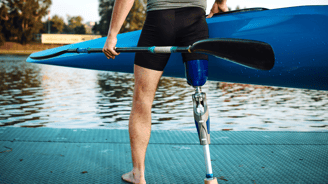 Have you ever stopped to consider how important your limbs are to your everyday life? They allow us to move, work, and play in ways we often take for granted. But for millions of people around the world, limb loss or limb difference is a reality they must face every day.
Have you ever stopped to consider how important your limbs are to your everyday life? They allow us to move, work, and play in ways we often take for granted. But for millions of people around the world, limb loss or limb difference is a reality they must face every day.
April is Limb Loss and Limb Difference Awareness Month, a time to raise awareness about the millions of people around the world who live with limb differences or have lost a limb. While the reasons for limb loss are varied, diabetes and vascular disease are the most common causes in the United States. Rural and agricultural communities may have unique risks and challenges related to limb loss.
Limb Loss vs. Limb Difference
Limb difference refers to any variation in the size or shape of a limb. This can be due to a congenital condition, injury, or illness. Limb loss, on the other hand, refers to the removal of a limb due to injury, disease, or surgical intervention. According to the Amputee Coalition, there are nearly 2 million people living with limb loss in the United States alone, and that number is expected to double by 2050.
Causes of Limb Loss
There are many causes of limb loss, but some are more common than others. Diabetes and vascular disease are the leading causes of non-traumatic limb loss in the United States. High blood sugar levels can damage nerves and blood vessels, leading to poor circulation and an increased risk of infection. Over time, this can lead to gangrene, a serious condition that can require amputation.
Traumatic limb loss, on the other hand, is often the result of accidents or injuries. This can include car accidents, workplace accidents, or sports injuries. In some cases, surgical intervention may be necessary to remove a limb due to cancer or other diseases.
Rural and Agricultural Communities Have Increased Risk
Agricultural work can be physically demanding and can expose workers to hazardous conditions. Machinery accidents, exposure to chemicals and pesticides, and repetitive motions are all common risks in this field. In rural communities, hunting and outdoor activities can also lead to traumatic injuries that can result in limb loss.
Rural and agricultural communities may have limited access to healthcare and rehabilitation services, making it more difficult for those who have experienced limb loss or limb difference to receive the care they need. This lack of access to resources and support can also lead to feelings of isolation and depression among those who have experienced limb loss or limb difference.
It’s important for those living in rural and agricultural communities to be aware of the risks associated with their work and to take steps to prevent injury whenever possible. This can include wearing protective gear, following safety guidelines when operating machinery, and seeking medical attention immediately after an injury.
For those who have already experienced limb loss or limb difference, it’s important to know that support and resources are available. The Amputee Coalition, for example, provides a range of resources and services to support those living with limb loss or limb difference, including peer support groups, educational materials, and access to prosthetic technology.
Hope Through Prosthetics
Despite the challenges faced by those who lose a limb, there is hope. Advances in prosthetic technology have made it possible for amputees to live active and fulfilling lives. Prosthetics can be customized to fit the needs and lifestyle of each individual, allowing them to perform tasks they never thought possible. Point Designs creates prosthetics and shares their hope for prosthetics technology.
Part of the recovery process after limb loss involves regaining as much functionality and independence as possible. Small differences, even the loss of only a middle and index finger, can result in a 40 percent disability of the hand and a 22 percent overall whole-body impairment.
While strength training and adapting the environment to a particular limb difference can help a lot, our world is inherently built for those with 10 fingers and 10 toes, which is why exploring prosthetic options can help with recovery tremendously.
Not only does it allow the user to accomplish tasks they wouldn’t have been able to do before, but it allows them the opportunity to embrace their limb difference, instead of feeling as if they must hide it.
With the advent of new technologies like 3D printing, and the increase in prosthesis availability for those with limb loss, customization options are more accessible than ever before.
Prosthetics can look like almost anything now, including your own skin. For some, embracing their limb difference means having a prosthesis that matches the rest of their body. This is where traditional prosthetic fabrication methods such as casting, molding, and anaplastology are most useful.
Regardless of what allows someone with limb loss to feel beautiful, powerful, and comfortable in their own skin, prosthetists, orthotists, and artists will always be available to help those with limb loss feel special, comfortable, and excited to embrace their differences.
[Read the full article click here]
However, the cost of prosthetics can be prohibitively high, and insurance coverage can be limited. This can be especially challenging for people in rural or low-income communities. That's why it's important to raise awareness about limb loss and limb difference, and to advocate for access to affordable healthcare and prosthetic technology.
How You Can Show Support
Limb loss and limb difference can affect anyone, regardless of their geographic location or profession. However, studies have shown that people living in rural and agricultural communities may be at an increased risk for limb loss and limb difference due to the nature of their work.
One way to get involved is to support organizations like the Amputee Coalition, which provides resources and support for people living with limb loss. You can also participate in events and fundraisers that raise awareness and support for the limb loss community.
Limb Loss and Limb Difference Awareness Month is an important opportunity to raise awareness about the millions of people living with limb differences or who have lost a limb. While the causes of limb loss are varied, diabetes and vascular disease are the most common in the United States.
Rural and agricultural communities may face unique challenges related to limb loss, including limited access to healthcare and increased risk due to the nature of their work. However, with advances in prosthetic technology and increased awareness, there’s hope for those who lose a limb to live active and fulfilling lives.
Your Orchard Hospital is happy to serve our rural and agricultural communities for their overall health and in the case of limb loss. We care about the prevention and treatment of both. Our clinic is open, click the link below to schedule your appointment, walk-ins are also welcome.



